Hydrodynamic Cross-Scale Archaeology at a Roman River Harbour
Abstract
:1. Introduction
- To investigate the hydraulic effects such as local energy loss for the specific structural design of the flow parallel quay wall
- To find an adequate representation of the quay-wall’s effect in a numeric model
- To develop a possible historic river bathymetry, employing the data of archaeological and geologic origin with the physics based sedimentation processes
- To examine the local effect of the possible current deflection wall under a realistic hydrodynamic global regime
2. Data and Methods
2.1. Cross-Scale Multi-Model Approach
- (i)
- Physical Flume Model
- A physical surrogate model of the archaeological roman wooden quay-wall is designed on a 1:2.42 scale, adhering the size of the experimental facility and the availability of construction timber on the retail market. This model is installed in a current flume for hydraulic experiments determining the wall-roughness induced loss alongside the quay wall. The geometric constraints are derived from the archaeological data, while information such as the water level and the velocity are chosen according to the numeric model of the river stretch. The influence of the tip pointing into the stream is not examined.
- (ii)
- Numerical Flume Model
- A simple conceptual numeric model of the experimental set-up is reproduced in Delft3D, where the quay-wall is included as a parametrized loss function. This numerical model is initially scaled at 2.42 to compare with physical lab results. In a second step, these are up-scaled to real-life dimensions to ensure correct adaption. The comparison allows for the identification of a value of the loss coefficient, that leads to a minimal difference in the velocity distribution of the experimental and numerical results.
- (iii)
- Numerical River Model
- Finally, a numerical river model (NRM) of the ancient Rhine containing the CUT stretch is developed. It comprises two steps. The first one is the generation of a physically plausible bathymetry using an active bed to simulate the morphological processes of the river. The second step is the examination of the hydrodynamics in vicinity of the harbour structures on basis of the bathymetry generated in step one, now neglecting the morphodynamics of the river.
- The model is combining archaeological field research data for reconstructing a detailed 3D-river bed with hind-cast time-series of ancient Rhine river discharge for forcing the model, including a morphologically active bed. In the second step, the representation of the parametric quay-wall structures to simulate the hydrodynamic effects observed during the initial physical laboratory tests is combined with a parametric representation of the possible current deflection wall (CDW) to account for the harbour influence.
2.2. Physical Flume Experiments
2.3. Numerical Model Flume
2.4. Rhine River Model
2.4.1. Rhine River Bathymetry
2.4.2. Hydrodynamic Calibration
2.4.3. Hydrodynamic Modelling of Harbour Structures
3. Results
3.1. Physical Flume Model
3.2. Numerical Flume Experiments
3.3. Numeric River Model
3.3.1. Morphodynamic Simulations of the Riverbed
3.3.2. Structure Impact
4. Discussion
4.1. Physical Model Tests
4.2. Numeric Flume Tests
4.3. Numeric River Model
5. Conclusions
- -
- A scaled physical model was constructed according to archaeological findings and installed in a hydraulic test facility to measure roughness induced reduction of flow on a longitudinal and a crosswise transect at five vertical levels. A substantial reduction of 30% near the wall is observed.
- -
- Measurements are compared against a conceptual numerical twin model of the physical laboratory experiments using Delft3D. This shows that the experimental velocity distribution can be reproduced well employing a linear friction loss a term with a loss coefficient of 10.
- -
- Combining (i) field data from the excavation site and the results from dendrochronological investigations of the wooden quai with (ii) hydrological re-analysis data for the historic Rhine river discharge regime and (iii) state of the art numerical engineering methods, a 2DH model of the Rhine river section harbouring the CUT with the Roman type wooden quay-wall is developed. The calibrated model reproduces near-natural historic hydrodynamic conditions, depicting a possible realization of the flow field along the Roman river harbour during normal flow.
- -
- The wooden quay-wall is numerically represented in a parametric form endued with the experimentally determined loss coefficient of 10. Consequently, the numerical Rhine river model correctly maps the 200 long parametric structure, which projects its roughness related hydrodynamic influence with digital exactitude into the adjacent water body. Consistently it can be inferred, that the wooden Roman jetty was successfully assessed and its hydrodynamic impact effectively reproduced using state of the art methods.
- -
- Finally, the unique wooden structure unearthed at the upstream tip of the jetty protruding into the river was included in the 2DH Rhine river model to unravel its functionality with scientific acuteness. Substantiated by testing various lengths at 45° obviating coincidental results, it is revealed that the structure exerts the hydrodynamic impact similar to a current-deflection-wall. With a degree of efficiency reducing current speeds by up to 25% or 0.15 to 0.20 in its wake along the quay-wall, the Roman hydraulic structure rivals present day designs.
Author Contributions
Funding
Acknowledgments
Conflicts of Interest
Abbreviations
| ADV | acoustic Doppler velocimeter |
| CDW | current deflection wall |
| ci | confidence interval |
| RGS | rigid sheet |
| CUT | Colonia Ulpia Traiana |
| MorFac | morphologic acceleration factor |
| NFM | numerical flume model |
| PFM | physical flume model |
| NRM | numerical river model |
| NHN16 | normal height null 2016 (in m) |
| SNR | signal-to-noise ratio (in %) |
| DD | domain decomposition |
| SWL | still water level |
References
- Merckel, C. Die Ingenieurtechnik im Alterthum; Springer: Berlin, Germany, 1899. [Google Scholar]
- Tölle-Kastenbein, R. Antike Wasserkultur; Beck’s archäologische Bibliothek, Beck: München, Germany, 1990. [Google Scholar]
- Oleson, J.P.; Brandon, C.; Cramer, S.M.; Cucitore, R.; Gotti, E.; Hohlfelder, R.L. The ROMACONS Project: A Contribution to the Historical and Engineering Analysis of Hydraulic Concrete in Roman Maritime Structures. Int. J. Naut. Archaeol. 2004, 33, 199–229. [Google Scholar] [CrossRef]
- Brandon, C.; Hohlfelder, R.L.; Oleson, J.P.; Stern, C. The Roman Maritime Concrete Study (ROMACONS): The harbour of Chersonisos in Crete and its Italian connection. Méditerranée 2005, 2005, 25–29. [Google Scholar] [CrossRef]
- Hanel, N. Die Militärlager von Vetera I und ihre Lagersiedlungen. In Colonia Ulpia Traiana; Müller, M., Ed.; Eine Veröffentlichung des Landschaftsverbandes Rheinland, LVR—Archäologischer Park Xanten/LVR—RömerMuseum, von Zabern: Mainz am Rhein, Germany, 2008; pp. 93–107. [Google Scholar]
- Schmitz, D. Das Lager Vetera II und seine Legionen. In Colonia Ulpia Traiana; Müller, M., Ed.; Eine Veröffentlichung des Landschaftsverbandes Rheinland, LVR—Archäologischer Park Xanten/LVR—RömerMuseum, von Zabern: Mainz am Rhein, Germany, 2008; pp. 141–170. [Google Scholar]
- Precht, G. Das Forum. In Colonia Ulpia Traiana; Müller, M., Ed.; Eine Veröffentlichung des Landschaftsverbandes Rheinland, LVR—Archäologischer Park Xanten/LVR—RömerMuseum, von Zabern: Mainz am Rhein, Germany, 2008; pp. 341–353. [Google Scholar]
- Eck, W. Die Gründung der Colonia Ulpia Traiana in ihrem politischen Kontext. In Colonia Ulpia Traiana; Müller, M., Ed.; Eine Veröffentlichung des Landschaftsverbandes Rheinland, LVR—Archäologischer Park Xanten/LVR—RömerMuseum, von Zabern: Mainz am Rhein, Germany, 2008; pp. 243–255. [Google Scholar]
- Erdrich, M. Der “Repräsentationsbau”—Überlegungen zum Charakter der Bebauung der Doppelinsula 11/18. In Colonia Ulpia Traiana; Müller, M., Ed.; Eine Veröffentlichung des Landschaftsverbandes Rheinland, LVR—Archäologischer Park Xanten/LVR—RömerMuseum, von Zabern: Mainz am Rhein, Germany, 2008; pp. 355–359. [Google Scholar]
- Kienzle, P. Die zivile Wohnbebauung in der CUT. In Colonia Ulpia Traiana; Müller, M., Ed.; Eine Veröffentlichung des Landschaftsverbandes Rheinland, LVR—Archäologischer Park Xanten/LVR—RömerMuseum, von Zabern: Mainz am Rhein, Germany, 2008; pp. 413–432. [Google Scholar]
- Müller, M. (Ed.) Colonia Ulpia Traiana; Eine Veröffentlichung des Landschaftsverbandes Rheinland, LVR—Archäologischer Park Xanten/LVR—RömerMuseum, von Zabern: Mainz am Rhein, Germany, 2008. [Google Scholar]
- Müller, M. Die Stadtmauer der CUT. In Colonia Ulpia Traiana; Müller, M., Ed.; Eine Veröffentlichung des Landschaftsverbandes Rheinland, LVR—Archäologischer Park Xanten/LVR—RömerMuseum, von Zabern: Mainz am Rhein, Germany, 2008; pp. 277–290. [Google Scholar]
- Müller, M. Das Amphitheater. In Colonia Ulpia Traiana; Müller, M., Ed.; Eine Veröffentlichung des Landschaftsverbandes Rheinland, LVR—Archäologischer Park Xanten/LVR—RömerMuseum, von Zabern: Mainz am Rhein, Germany, 2008; pp. 361–372. [Google Scholar]
- Precht, G. Das Kapitol. In Colonia Ulpia Traiana; Müller, M., Ed.; Eine Veröffentlichung des Landschaftsverbandes Rheinland, LVR—Archäologischer Park Xanten/LVR—RömerMuseum, von Zabern: Mainz am Rhein, Germany, 2008; pp. 291–310. [Google Scholar]
- Precht, G. Die früheste römische Besiedlung im Gebiet der späteren CUT. In Colonia Ulpia Traiana; Müller, M., Ed.; Eine Veröffentlichung des Landschaftsverbandes Rheinland, LVR—Archäologischer Park Xanten/LVR—RömerMuseum, von Zabern: Mainz am Rhein, Germany, 2008; pp. 171–209. [Google Scholar]
- Schalles, H.J. Der Hafentempel. In Colonia Ulpia Traiana; Müller, M., Ed.; Eine Veröffentlichung des Landschaftsverbandes Rheinland, LVR—Archäologischer Park Xanten/LVR—RömerMuseum, von Zabern: Mainz am Rhein, Germany, 2008; pp. 311–318. [Google Scholar]
- Zieling, N. Die Thermen. In Colonia Ulpia Traiana; Müller, M., Ed.; Eine Veröffentlichung des Landschaftsverbandes Rheinland, LVR—Archäologischer Park Xanten/LVR—RömerMuseum, von Zabern: Mainz am Rhein, Germany, 2008; pp. 373–389. [Google Scholar]
- Selke, V. Zum Stand der Erforschung des Hafens der Colonia Ulpia Traiana/Xanten. In Der Rhein als europäische Verkehrsachse II, Volume 19, Bonner Beiträge zur Vor- und Frühgeschichtlichen Archäologie; Bemmann, J., Mirschenz, M., Eds.; Vor- und Frühgeschichtliche Archäologie Rheinische Friedrich-Wilhelms-Universität: Bonn, Germany, 2016; pp. 335–350. [Google Scholar]
- Gerlach, R.; Herchenbach, M.; Meurers-Balke, J. Das Rheinufer vor der Colonia Ulpia Traiana. In Archäologie im Rheinland 2016; Archäologie im Rheinland, Theiss: Darmstadt, Germany, 2017; pp. 114–116. [Google Scholar]
- von Petrikovits, H. Die Ausgrabungen in der Colonia Traiana bei Xanten: Die Ausgrabung der Kernsiedlung und der Uferanlagen (1934–1936). In Bonner Jahrbücher des Rheinischen Landesmuseums in Bonn; Butzon & Bercker: Kevelaer, Germany, 1952. [Google Scholar]
- Schmidt, B. Das Bauholz für die römerzeitlichen Häfen in Xanten und Köln: Eine Interpretation der dendrochronologischen Datierungen. In Von Anfang an: Archäologie in Nordrhein-Westfalen: [Begleitbuch zur Landesausstellung Von Anfang an—Archäologie in Nordrhein-Westfalen, Köln, Römisch-Germanisches Museum 13. März bis 28. August 2005, Herne, Westfälisches Museum für Archäologie, Landesmuseum 22. September 2005 bis 5. Februar 2006; Horn, H.G., Hellenkemper, H., Isenberg, G., Kunow, J., Eds.; Schriften zur Bodendenkmalpflege in Nordrhein-Westfalen, Verlag Philipp von Zabern: Mainz am Rhein, Germany, 2005; pp. 201–207. [Google Scholar]
- Leih, S. Der Hafen der Colonia Ulpia Traiana. In Colonia Ulpia Traiana; Müller, M., Ed.; Eine Veröffentlichung des Landschaftsverbandes Rheinland, LVR—Archäologischer Park Xanten/LVR—RömerMuseum, von Zabern: Mainz am Rhein, Germany, 2008; Volume 1, pp. 447–469. [Google Scholar]
- Selke, V. Der Hafen der Colonia Ulpia Traiana/Xanten. In Der Rhein als Europäische Verkehrsachse III; Mirschenz, M., Gerlach, R., Bemmann, J., Eds.; Bonner Beiträge 22, Vor- und Frühgeschichtliche Archäologie, Rheinische Friedrich-Wilhelms-Universität Bonn: Bonn, Germany, 2019. [Google Scholar]
- Jimenez, J. Turbulent flows over rough walls. Annu. Rev. Fluid Mech. 2004, 36, 173–196. [Google Scholar] [CrossRef]
- Leandro, J.; Bung, D.B.; Carvalho, R. Measuring void fraction and velocity fields of a stepped spillway for skimming flow using non-intrusive methods. Exp. Fluids 2014, 55. [Google Scholar] [CrossRef]
- Uijttewaal, W.S.J.; Lehmann, D.; van Mazijk, A. Exchange Processes between a River and Its Groyne Fields: Model Experiments. J. Hydraul. Eng. 2001, 127, 928–936. [Google Scholar] [CrossRef]
- Chanson, H. Hydraulics of skimming flows over stepped channels and spillways. J. Hydraul. Res. 1994, 32, 445–460. [Google Scholar] [CrossRef] [Green Version]
- Lojek, O.; Dempwolff, L.C.; Goseberg, N.R. Hydronumerische Simulation von Strömungsprozessen im Nahfeld des Römerhafens der Colonia Ulpia Triana: Der Rhein als europäische Verkehrsachse III: Bonner Beiträge zur Vor- und Frühgeschichtlichen Archäologie. In Der Rhein als Europäische Verkehrsachse III; Mirschenz, M., Gerlach, R., Bemmann, J., Eds.; Vor- und Frühgeschichtliche Archäologie, Rheinische Friedrich-Wilhelms-Universität Bonn: Bonn, Germany, 2019; Volume 22, pp. 109–120. [Google Scholar]
- Stoschek, O.; Matheja, A.; Zimmermann, C. Underwater structures against sedimentation at a ship berth in a tidal river. In Conference on Coastal and Port Engineering in Developing Countries COPEDEC; COPEDEC, Ed.; PIANC Secrétariat Général: Sri Lanka, Colombo, 2003; Volume 6, pp. 1–12. [Google Scholar]
- Matheja, A.; Stoschek, O.; Geils, J.; Zimmermann, C. Effetcs of a Current Deflection Wall in a tidal harbour entrance. In Conference on Coastal and Port Engineering in Developing Countries COPEDEC; COPEDEC, Ed.; PIANC Secrétariat Général: Sri Lanka, Colombo, 2003; Volume 6, pp. 1–12. [Google Scholar]
- van Maren, D.S.; Winterwerp, J.C.; Decrop, B.; Wang, Z.B.; Vanlede, J. Predicting the effect of a Current Deflecting Wall on harbour siltation. Cont. Shelf Res. 2011, 31, S182–S198. [Google Scholar] [CrossRef]
- Knüppel, J. Current deflection wall, Köhlfleet: Measure analysis in the framework of the Interreg IVB project TIDE: Elbe Estuary. Interreg IVB North Sea Reg. Progr. 2012, 2012, 1–12. [Google Scholar]
- PIANC. Minimising Harbour Siltation: PIANC Report n° 102, Vol. 102, Minimising Harbour Siltation; PIANC Secrétariat Général: Bruxelles, Belgium, 2008. [Google Scholar]
- Schendel, A.; Goseberg, N.; Schlurmann, T. Erosion Stability of Wide-Graded Quarry-Stone Material under Unidirectional Current. J. Waterw. Port Coast. Ocean Eng. 2016, 142, 04015023. [Google Scholar] [CrossRef] [Green Version]
- Hughes, S.A. Physical Models and Laboratory Techniques in Coastal Engineering; Advanced Series on Ocean Engineering; World Scientific Pub. Co.: Singapore; River Edge, NJ, USA, 1993; Volume 7. [Google Scholar]
- Frostick, L.E.; McLelland, S.J.; Mercer, T.G. Users Guide to Physical Modelling and Experimentation: Experience of the HYDRALAB Network; IAHR Design Manual, CRC Press: Hoboken, NJ, USA, 2011. [Google Scholar]
- Webb, C.B.; Barfuss, S.L.; Johnson, M.C. Modelling roughness in scale models. J. Hydraul. Res. 2010, 48, 260–264. [Google Scholar] [CrossRef]
- Sulaiman, M.; Sinnakaudan, S.; Shukor, M. Near bed turbulence measurement with acoustic doppler velocimeter (ADV). KSCE J. Civil Eng. 2013, 17, 1515–1528. [Google Scholar] [CrossRef]
- Goring, D.G.; Nikora, V.I. Despiking Acoustic Doppler Velocimeter Data. J. Hydraul. Eng. 2002, 128, 117–126. [Google Scholar] [CrossRef] [Green Version]
- Lesser, G.R.; Roelvink, J.A.; van Kester, J.; Stelling, G.S. Development and validation of a three-dimensional morphological model. Coast. Eng. 2004, 51, 883–915. [Google Scholar] [CrossRef]
- Stelling, G.S.; Leendertse, J.J. Approximation of Convective Processes by Cyclic AOI Methods. In Proceedings of the ASCE 2nd Conference on Estuarine and Coastal Modeling, Tampa, FL, USA, 13–15 November 1992; pp. 771–782. [Google Scholar]
- Deltares. Delft3D-FLOW: Simulation of Multi-Dimensional Hydrodynamic Flows and Transport Phenomena, Including Sediments—User Manual: Hydro-Morphodynamics; Deltares: Delft, The Netherlands, 2004; pp. 1–712. [Google Scholar]
- Khuntia, J.R.; Devi, K.; Khatua, K.K. Prediction of depth-averaged velocity in an open channel flow. Appl. Water Sci. 2018, 8, 172. [Google Scholar] [CrossRef] [Green Version]
- Charlier, D. Ergänzungen und Korrekturen zur Untersuchung der Bohrkerne aus dem Hafen der CUT: Unveröffentlichte Gutachten: “Ergebnisse der Nachbestimmung Ausgewählter Bohrkerne”, unpublished report 1995.
- Gerlach, R.; Fischer, P.; Meurers-Balke, J.; Mirschenz, M.; Röpke, A.; Hadler, H.; Willershäuser, T.; Vött, A. Römische Hafenstandorte: Standortbedingungen und Flussdynamik am Niedergermanischen Rheinlimes von Königswinter bis Kleve-Rindern. In Der Rhein als europäische Verkehrsachse III; Mirschenz, M., Gerlach, R., Bemmann, J., Eds.; Bonner Beiträge 22, Vor- und Frühgeschichtliche Archäologie, Rheinische Friedrich-Wilhelms-Universität Bonn: Bonn, Germany, 2019. [Google Scholar]
- Herget, J.; Roggenkamp, T.; Krell, M. Estimation of peak discharges of historical floods. Hydrol. Earth Syst. Sci. 2014, 18, 4029–4037. [Google Scholar] [CrossRef] [Green Version]
- Deutsches Gewässerkundliches Jahrbuch. 2020. Available online: https://www.lfu.bayern.de/wasser/wasserstand_abfluss/dgj/index.htm (accessed on 22 April 2020).
- QGIS_Dev. Team. Quantum Geographic Information System: QGIS: 64 Bit. 2019. Available online: https://qgis.org/en/site/ (accessed on 27 November 2020).
- Roggenkamp, T. Der Rhein zur Römerzeit: Wasserstände und Abflüsse des Mittel- und Niederrheins. In Forschungen. Geographie und Landeskunde; Deutsche Akademie für Landeskunde: Leipzig, Germany, 2016; Band 264. [Google Scholar]
- Courant, R.; Friedrichs, K.; Lewy, H. Über die partiellen Differenzgleichungen der mathematischen Physik. Math. Ann. 1928, 100, 32–74. [Google Scholar] [CrossRef]
- Dissanayake, P.K.; Wurpts, A.; Miani, M.; Knaack, H. Modelling Anthropogenic Effect of a Tidal Basin Evolution. Coast. Eng. Proc. 2012, 1, 50. [Google Scholar] [CrossRef]
- van der Wegen, M. Modeling Morphodynamic Evolution in Alluvial Estuaries: UNESCO-IHE; Taylor and Francis: Hoboken, NJ, USA, 2011. [Google Scholar]
- Dissanayake, D.M.P.K.; Ranasinghe, R.; Roelvink, J.A. The morphological response of large tidal inlet/basin systems to relative sea level rise. Clim. Chang. 2012, 113, 253–276. [Google Scholar] [CrossRef] [Green Version]
- van der Wegen, M.; Roelvink, J.A. Long-term morphodynamic evolution of a tidal embayment using a two-dimensional, process-based model. J. Geophys. Res. 2008, 113, 390. [Google Scholar] [CrossRef] [Green Version]
- Roelvink, J.A. Coastal morphodynamic evolution techniques. Coast. Eng. 2006, 53, 277–287. [Google Scholar] [CrossRef]
- Saberi, O.; Galoie, M. Numerical Modeling of Flow Around Groynes with Different Shapes Using TELEMAC-3D Software. Am. J. Water Sci. Eng. 2017, 2, 43–52. [Google Scholar] [CrossRef]
- Müller, M. Die städtebauliche Entwicklung von der Coloniagründung bis zur Spätantike. In Colonia Ulpia Traiana; Müller, M., Ed.; Eine Veröffentlichung des Landschaftsverbandes Rheinland, LVR—Archäologischer Park Xanten/LVR—RömerMuseum, von Zabern: Mainz am Rhein, Germany, 2008; pp. 269–273. [Google Scholar]
- Rolvink, J.A.; Van Banning, G.K.F.M.; IAHR. Design and development of Delft3D and Application to Coastal Morphodynamics. In Proceedings of the First International Conference on Hydroinformatics, Delft, The Netherlands, 19–23 September 1994; Balkema: Rotterdam, The Netherlands, 1994; Volume 1. [Google Scholar]
- Obladen-Kauder, J. Spuren römischer Lastschifffahrt am Unteren Niederrhein. In Colonia Ulpia Traiana; Müller, M., Ed.; Eine Veröffentlichung des Landschaftsverbandes Rheinland, LVR—Archäologischer Park Xanten/LVR—RömerMuseum, von Zabern: Mainz am Rhein, Germany, 2008. [Google Scholar]
- Gerlach, R.; Meurers-Balke, J. Der Prallhang als Standortvorteil—Der römische Rhein bei Burginatium. In Archäologie im Rheinland 2013; Archäologie im Rheinland, Theiss, Konrad: Darmstadt, Germany, 2014; pp. 114–117. [Google Scholar]
- Gerlach, R.; Meurers-Balke, J. Wo wurden römische Häfen am Niederrhein angelegt? Die Beispiele Colonia Ulpia Traiana (Xanten) und Burginatium (Kalkar). In Der Rhein als Europäische Verkehrsachse: Die Römerzeit; Kennecke, H., Ed.; Bonner Beiträge zur Vor- und Frühgeschichtlichen Archäologie, Vor- und Frühgeschichtliche Archäologie Rheinische Friedrich-Wilhelms-Univ: Bonn, Germany, 2014. [Google Scholar]
Sample Availability: Samples of the compounds are available from the authors. |
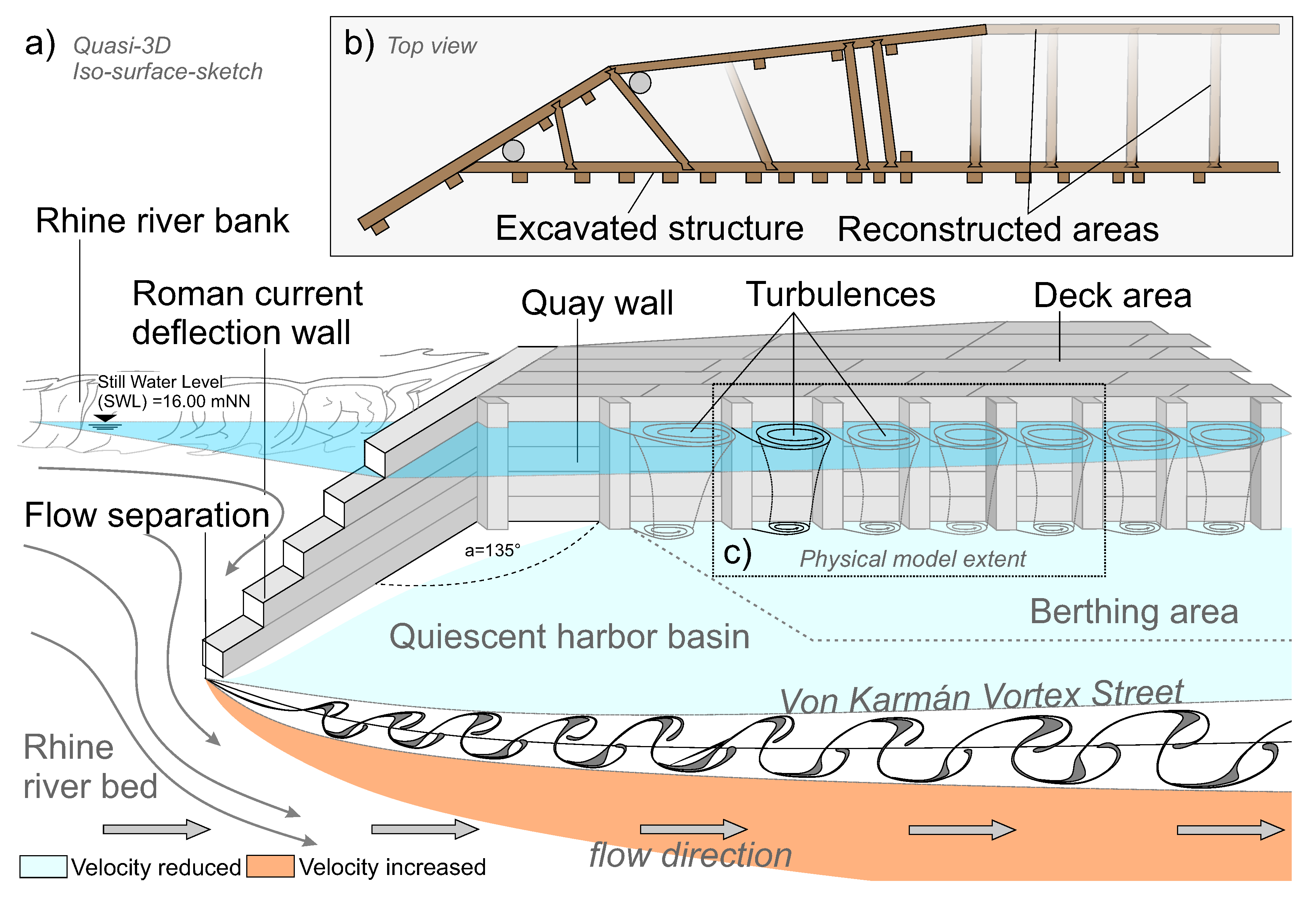
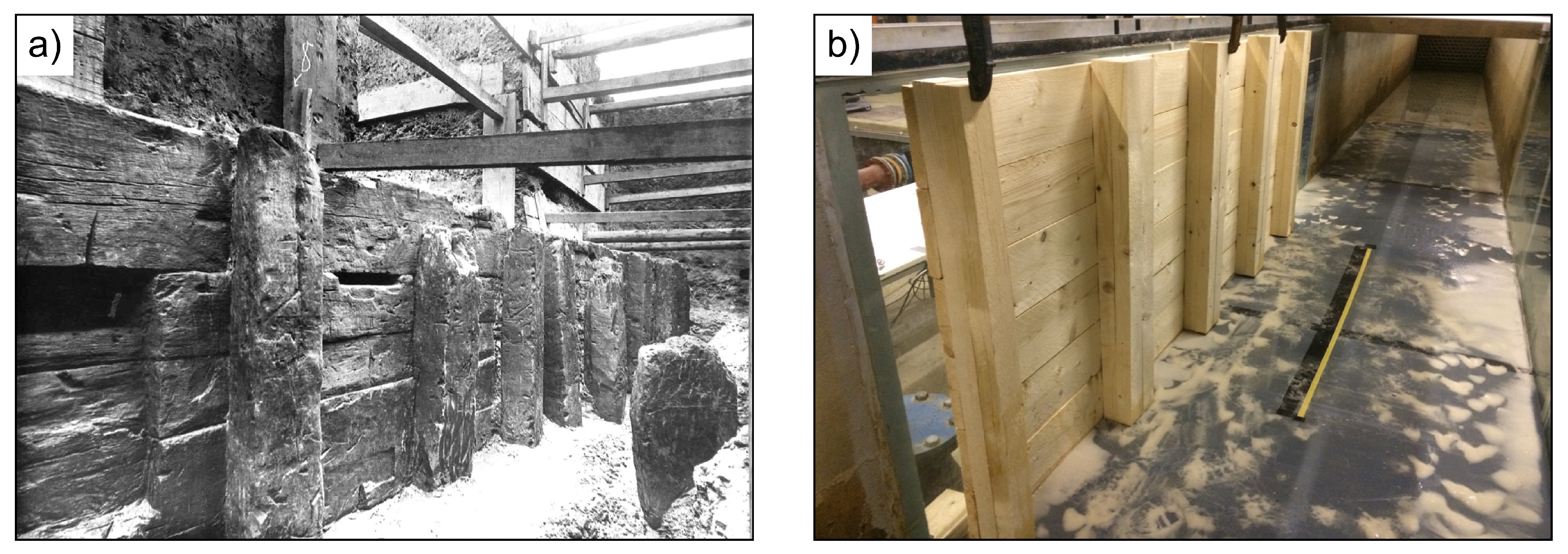
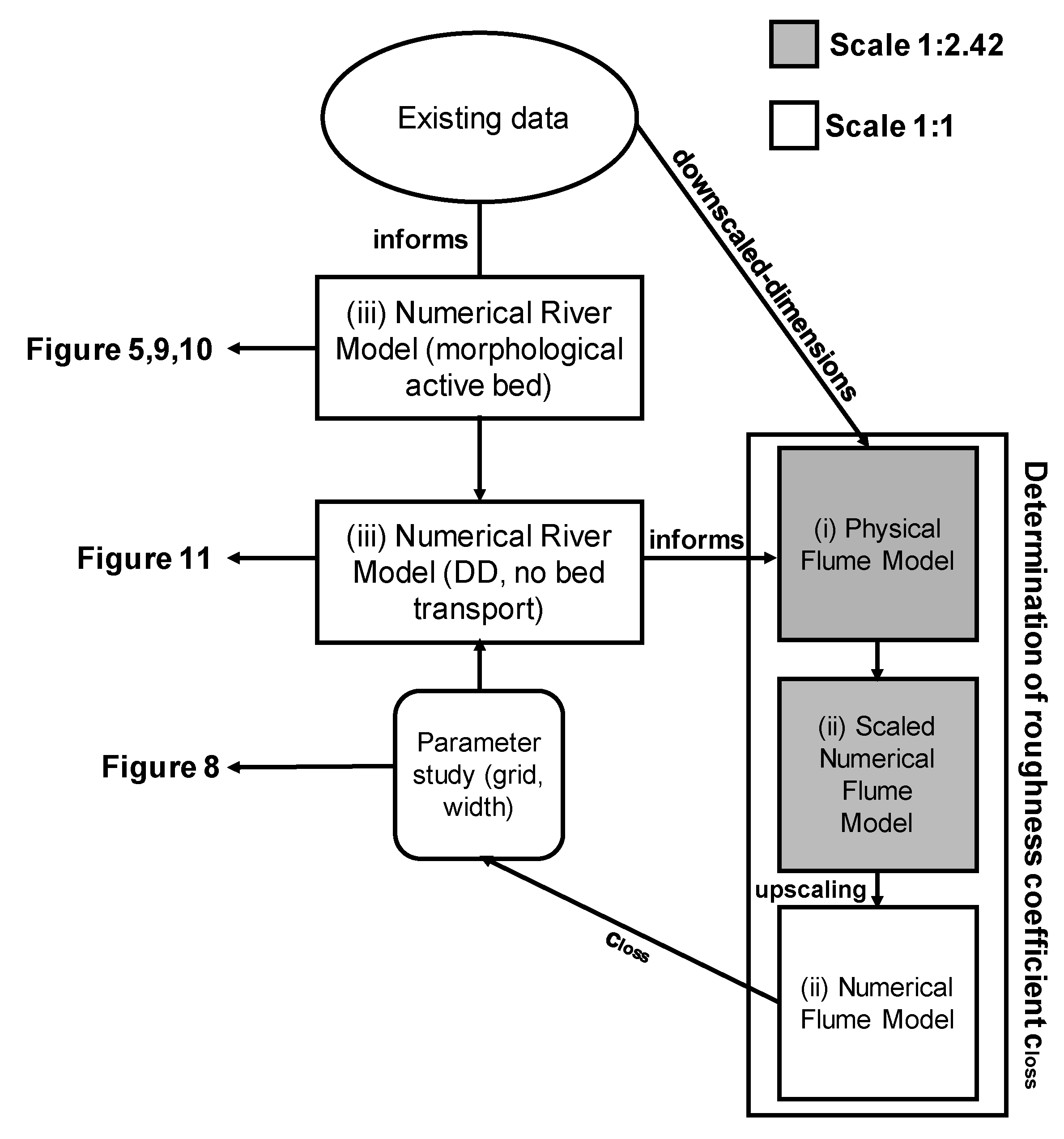
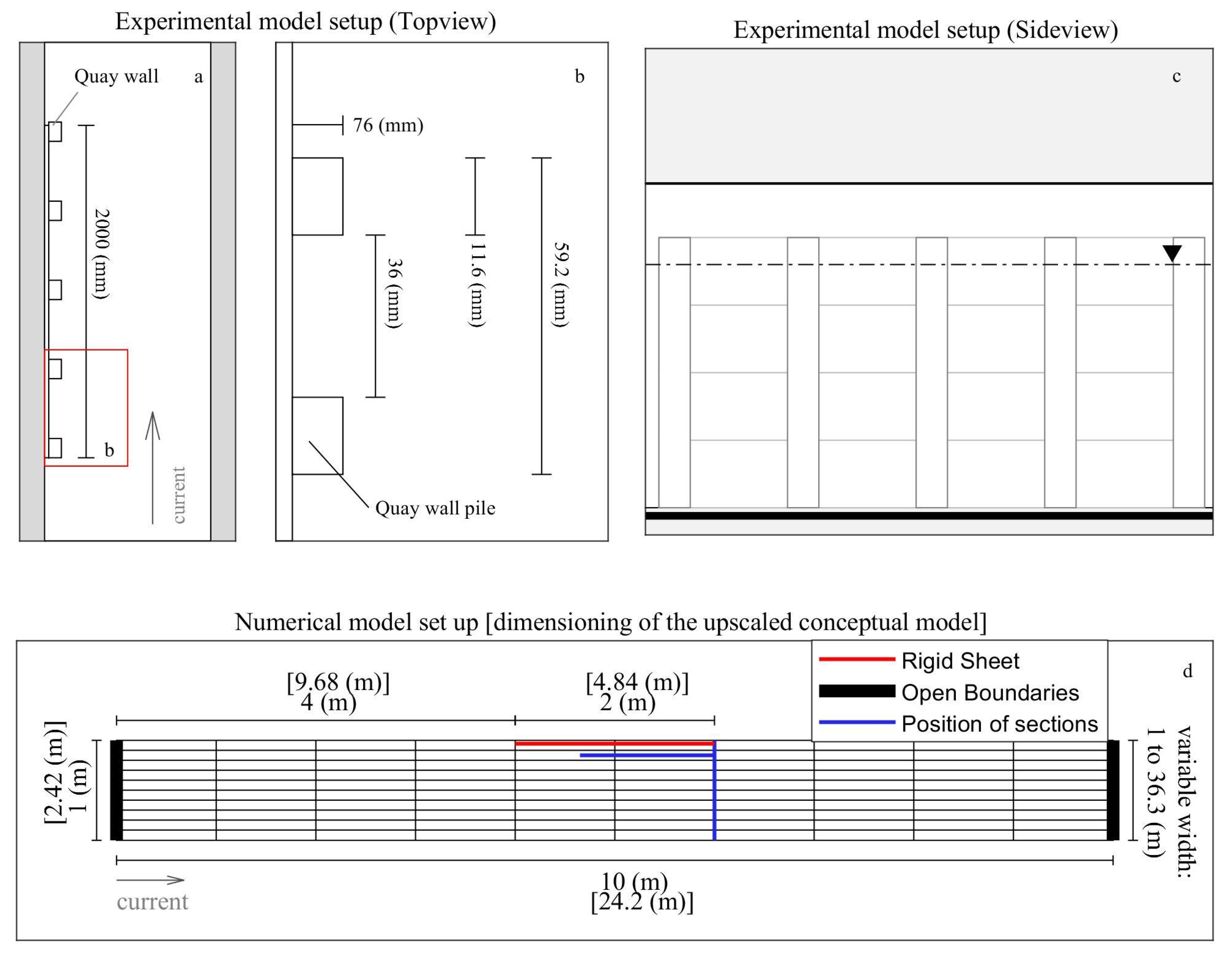
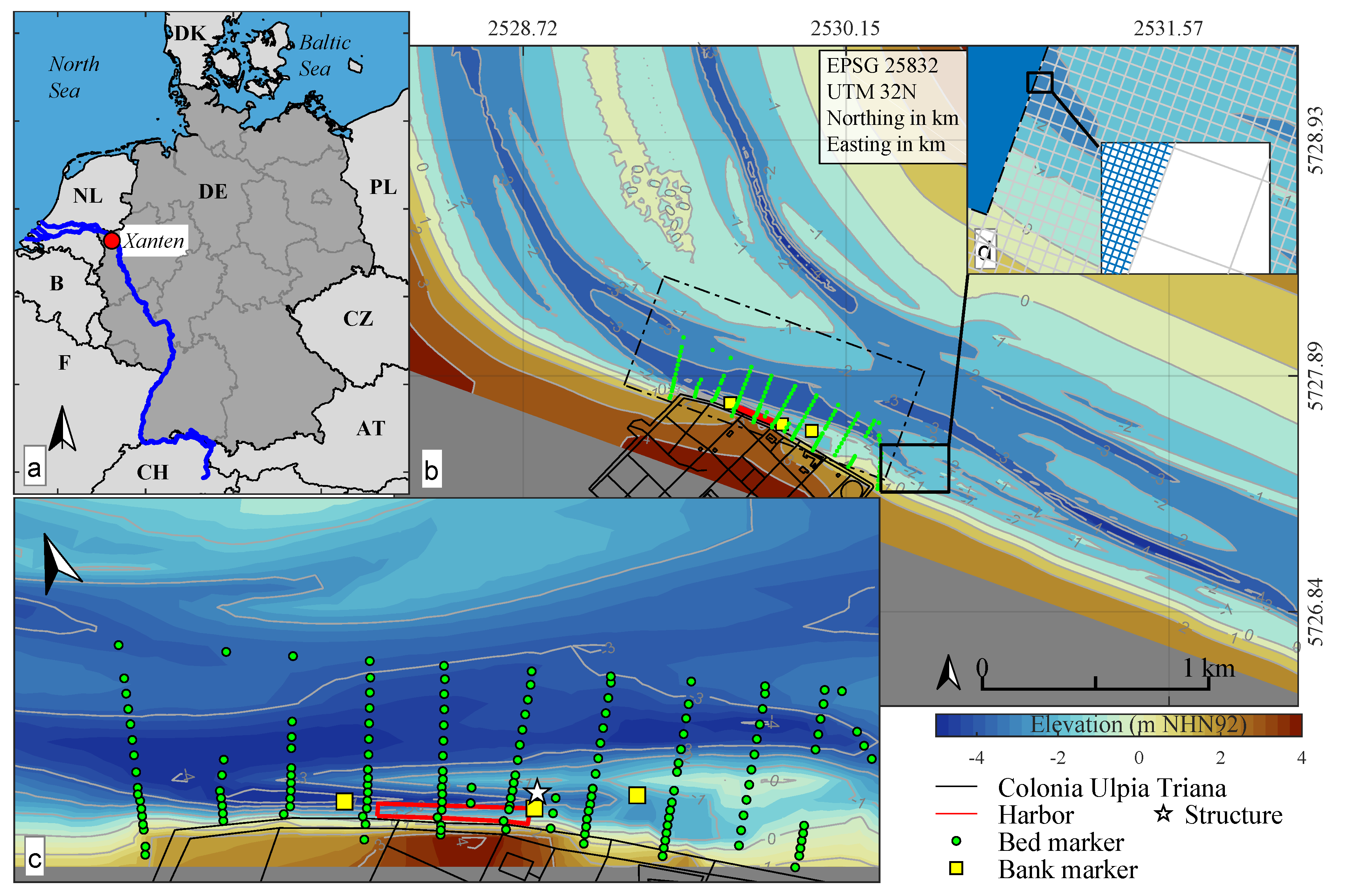
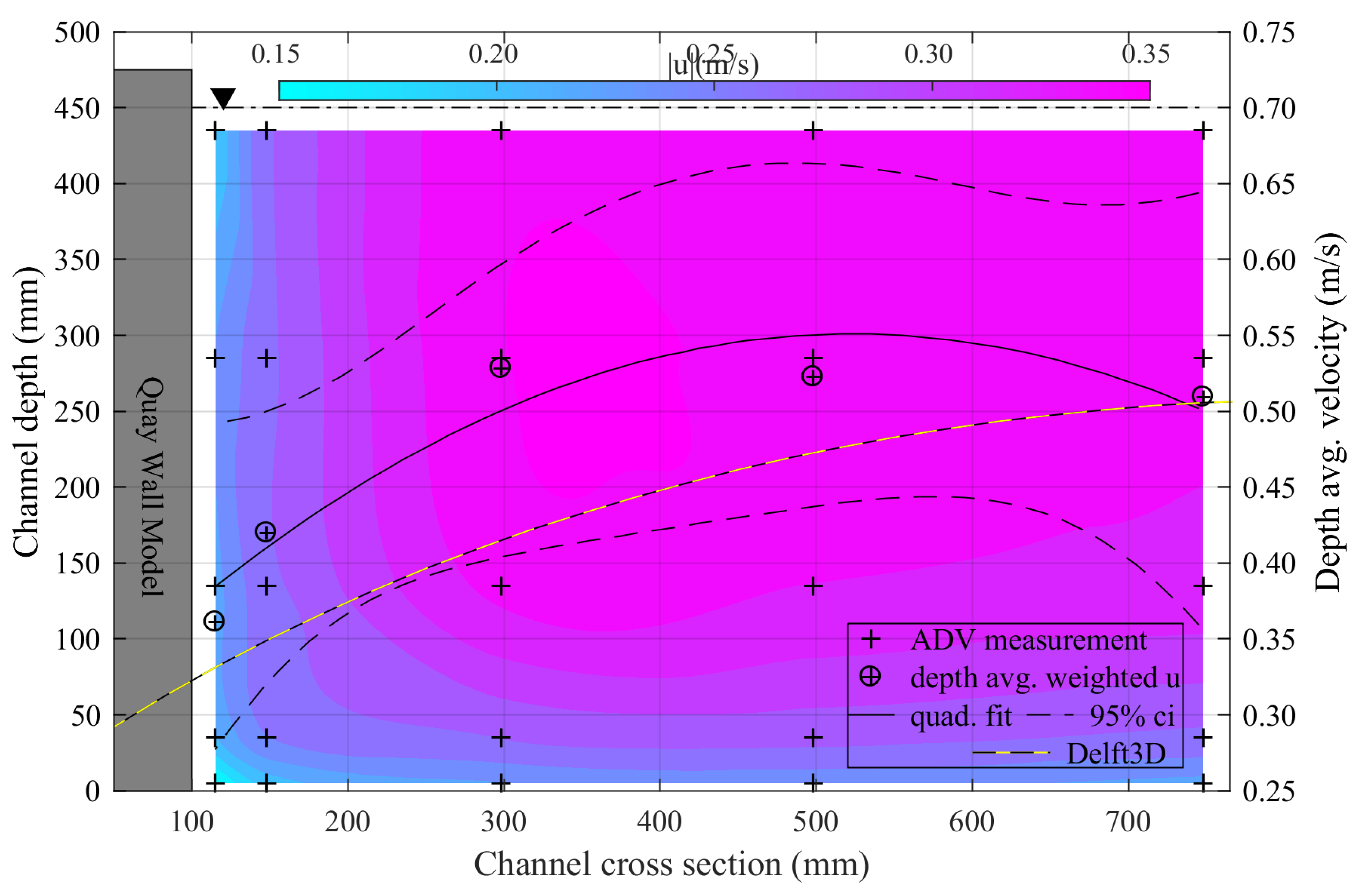
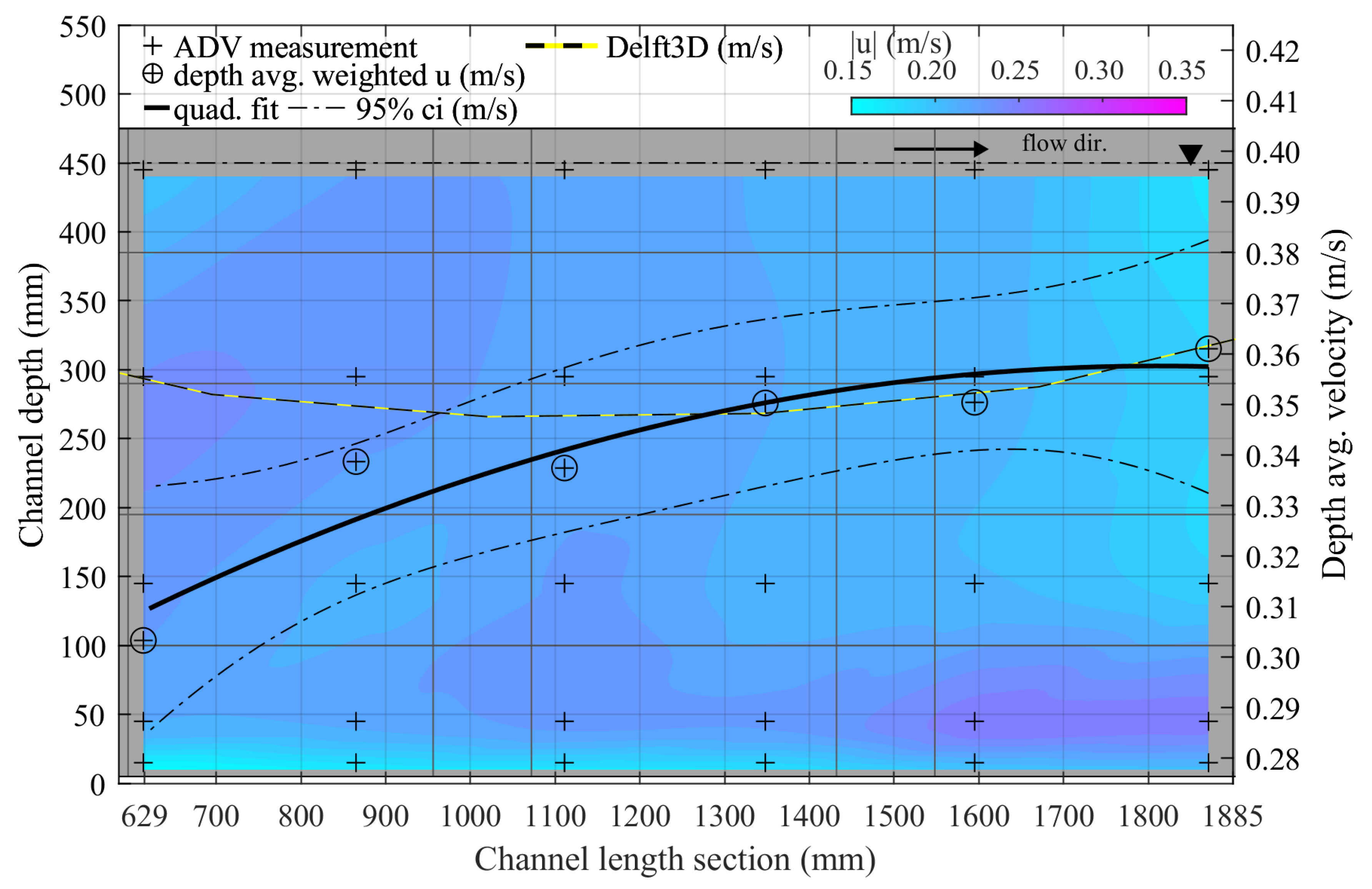
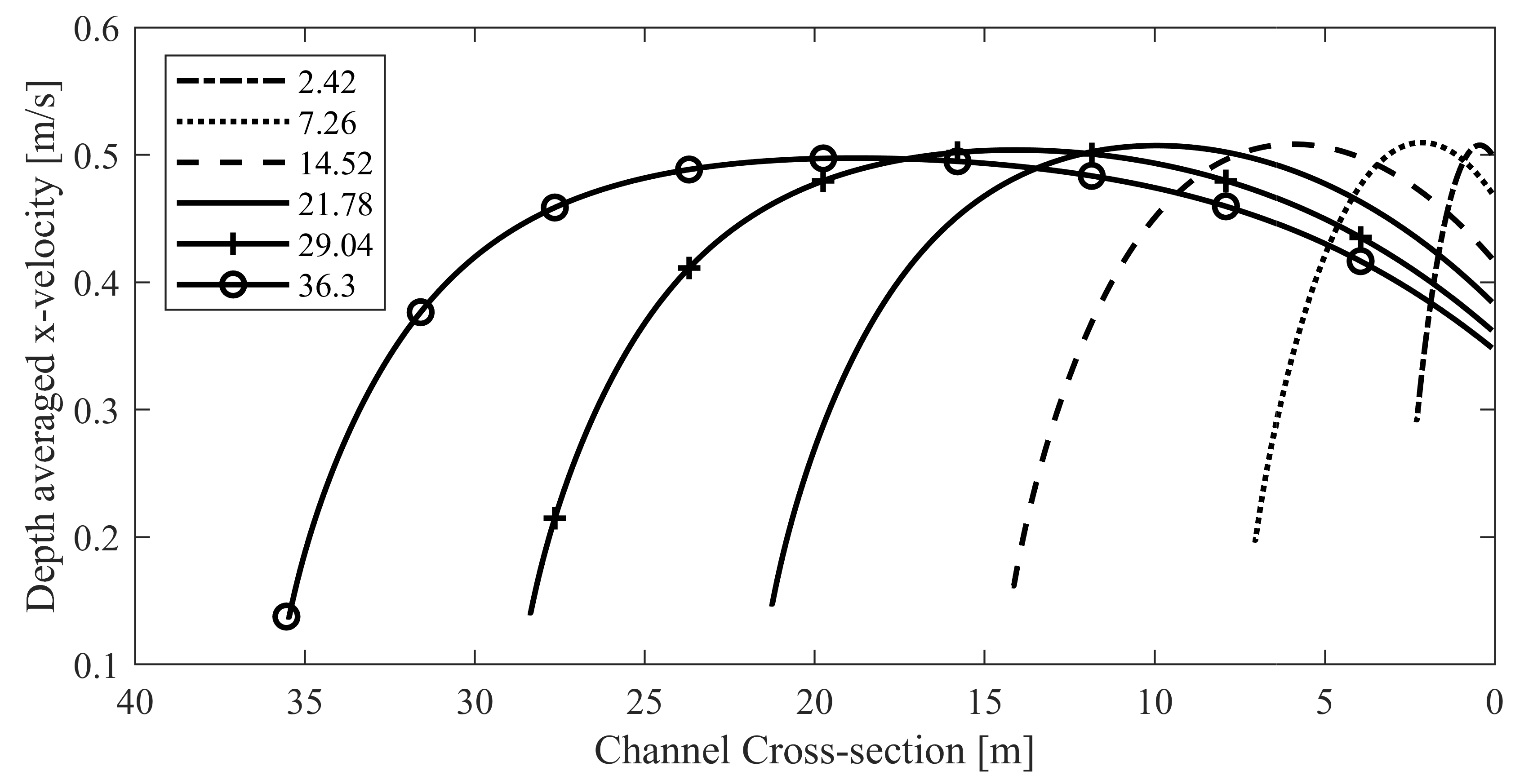
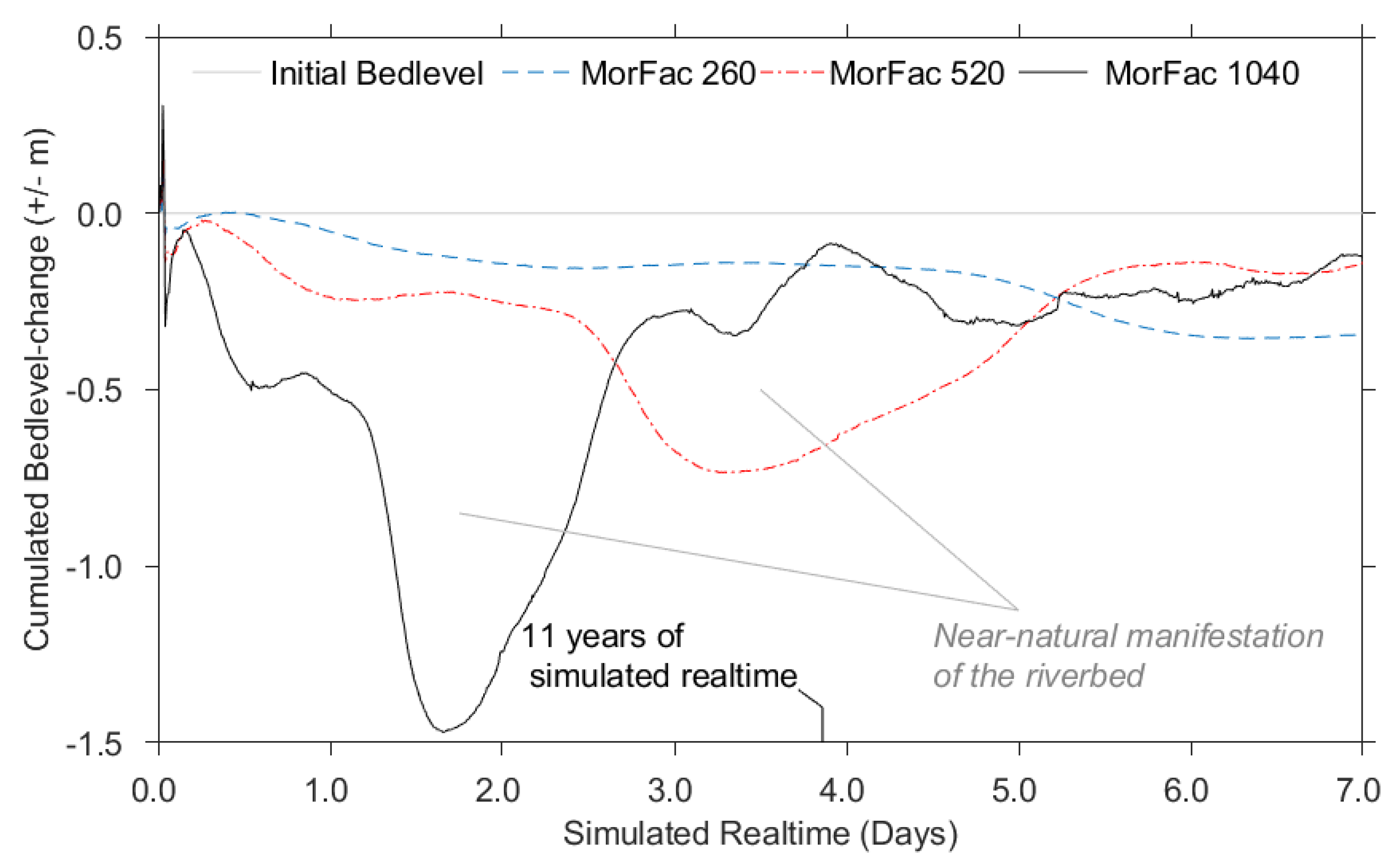
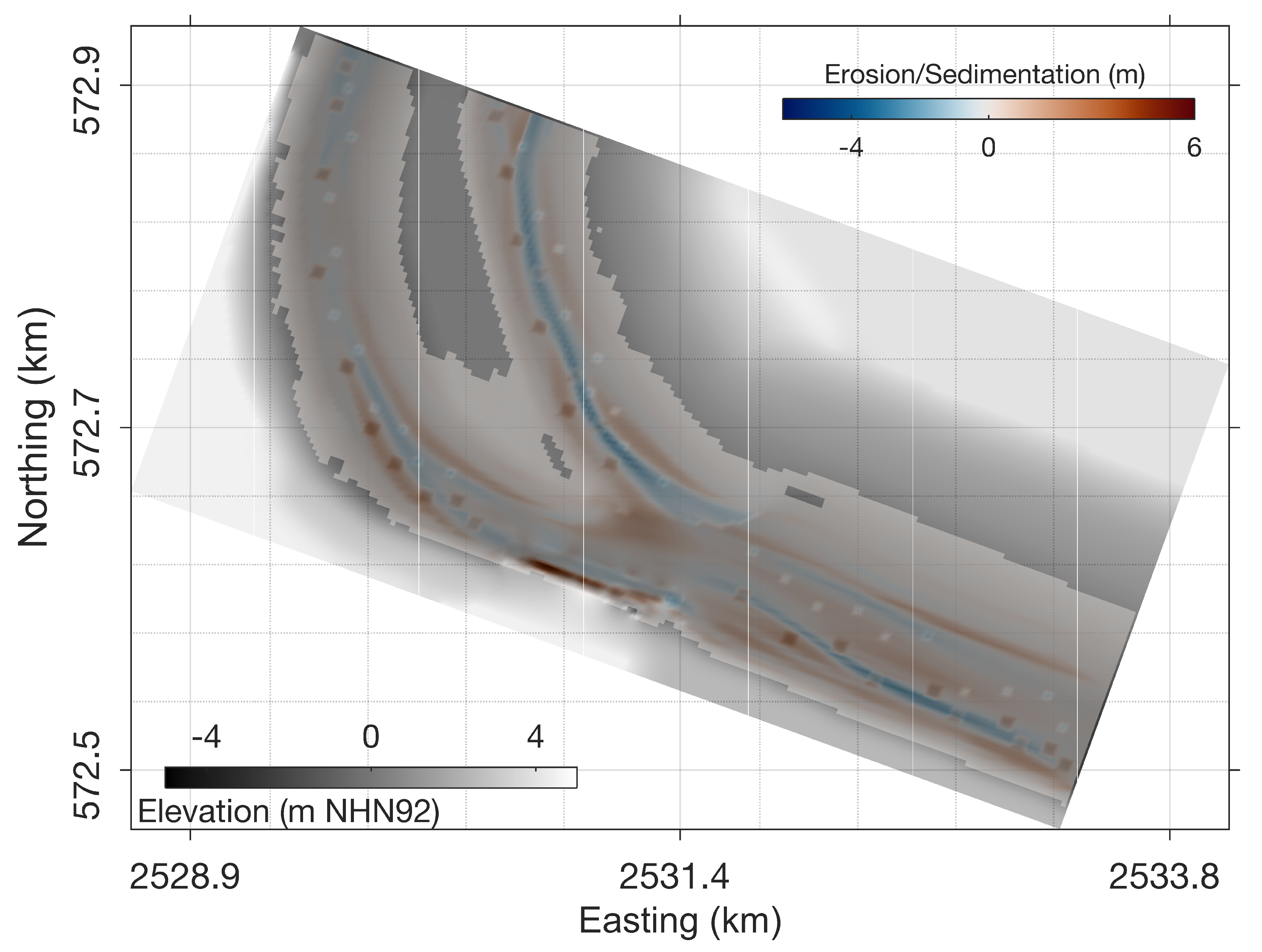
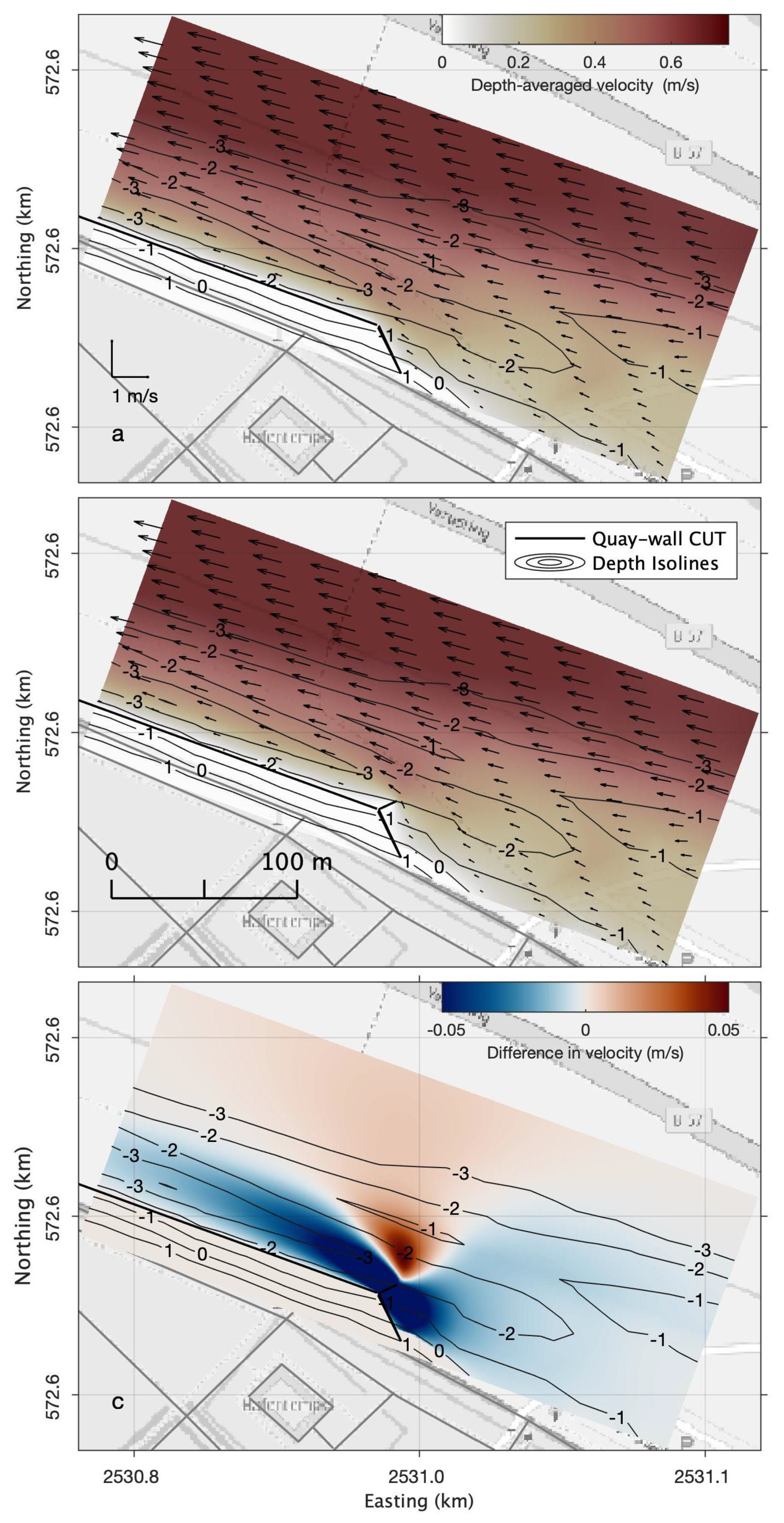
| Parameter | Symb. | Unit | cSa | mSa | fSa |
|---|---|---|---|---|---|
| grain diameter | () | 2.2 | 1.5 | 0.8 | |
| layer thickness | m | () | 7.0 | 1.5 | 0.2 |
| dry bulk density | () | 1650 | 1650 | 1650 |
Publisher’s Note: MDPI stays neutral with regard to jurisdictional claims in published maps and institutional affiliations. |
© 2020 by the authors. Licensee MDPI, Basel, Switzerland. This article is an open access article distributed under the terms and conditions of the Creative Commons Attribution (CC BY) license (http://creativecommons.org/licenses/by/4.0/).
Share and Cite
Dempwolff, L.-C.; Lojek, O.; Selke, V.; Goseberg, N.; Gerlach, R. Hydrodynamic Cross-Scale Archaeology at a Roman River Harbour. Water 2020, 12, 3365. https://doi.org/10.3390/w12123365
Dempwolff L-C, Lojek O, Selke V, Goseberg N, Gerlach R. Hydrodynamic Cross-Scale Archaeology at a Roman River Harbour. Water. 2020; 12(12):3365. https://doi.org/10.3390/w12123365
Chicago/Turabian StyleDempwolff, León-Carlos, Oliver Lojek, Valeria Selke, Nils Goseberg, and Renate Gerlach. 2020. "Hydrodynamic Cross-Scale Archaeology at a Roman River Harbour" Water 12, no. 12: 3365. https://doi.org/10.3390/w12123365






